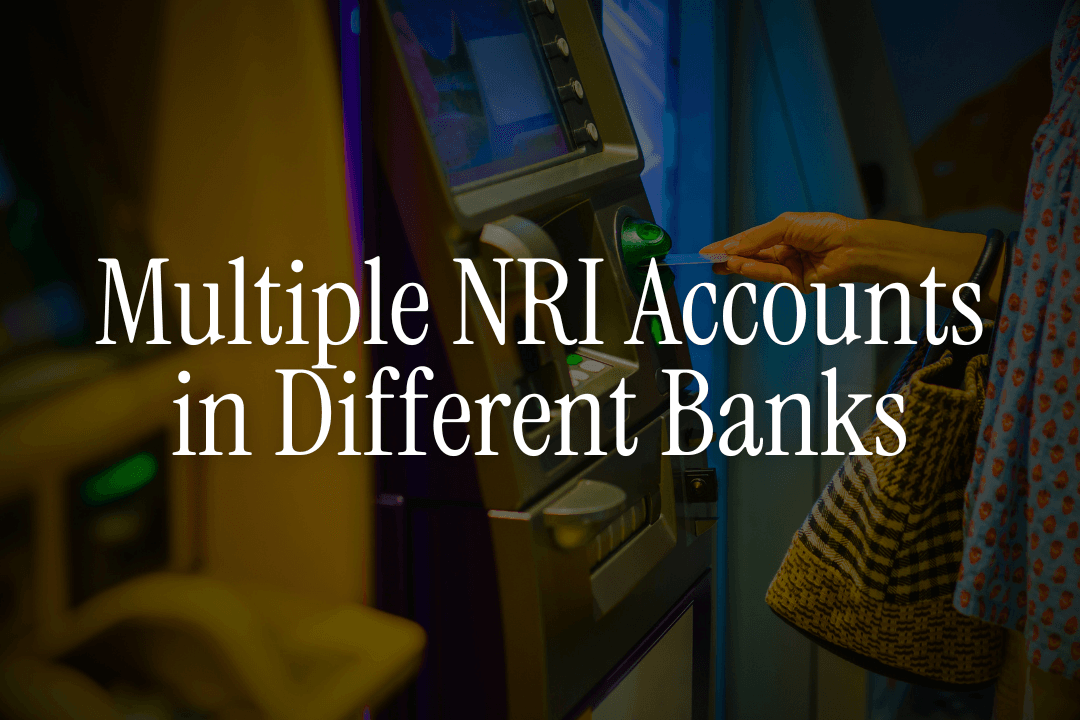
Last Tuesday, I got a WhatsApp message from Deepak in Dubai: "Bro, my colleague says RBI will freeze my accounts if I have more than two. But HDFC is offering 7.2% on FDs while my ICICI gives only 6.8%. Can I open another account or not?"
I've heard this question over 200 times in the last two years. NRIs are constantly confused between wanting better returns and fearing they'll accidentally break some banking rule that'll land them in trouble.
Here's what I told Deepak, and what I'm telling you: Yes, you can absolutely hold multiple NRI accounts across different banks. RBI has zero restrictions on this.
But there's a smart way and a really expensive way to do it.
By the end of this guide, you'll know exactly which accounts you can multiply, the hidden costs that banks conveniently forget to mention, how the new 2025 compliance rules affect you, and the proven 2+1 strategy that 90% of my successful NRI clients use to maximize returns while staying completely compliant.
What RBI's Rules Actually Say (Not What Banks Tell You)
Let me start with the official position, because there's too much misinformation floating around.
The RBI's stance is crystal clear: You can hold multiple NRE, NRO, and FCNR accounts across different banks. Period. There's no upper limit mentioned anywhere in FEMA regulations.
I pulled up the actual RBI Master Direction to double-check this. Here's what it says:
- NRIs can open accounts "with any Authorized Dealer bank"
- No numerical restriction on accounts per person
- Each account must comply with individual KYC requirements
- All accounts must serve legitimate banking purposes
Translation: You could theoretically have 15 different NRI accounts if you wanted. The question isn't whether you can - it's whether you should.
RBI cares about two things: proper compliance and legitimate use. As long as you can justify why you have multiple accounts and keep your paperwork straight, you're fine.
👉 Tip: Always have a clear reason for each account you open. "Better FD rates" or "superior customer service" are perfectly valid reasons in RBI's eyes.
Breaking Down Each Account Type: What You Can Actually Do
NRE Accounts: Zero Restrictions, Maximum Flexibility
Short answer: No limits whatsoever.
I know NRIs with 5-6 NRE accounts across different banks. Here's why they do it:
Priya (Software Engineer, Abu Dhabi):
- ICICI NRE: Primary salary account (great UAE customer service)
- SBI NRE: Fixed deposits (usually offers highest rates)
- HDFC NRE: Family support transfers (parents prefer HDFC branches)
- Kotak NRE: High-interest savings for emergency funds
Each NRE account is completely tax-free and fully repatriable, so you can move money between them without any restrictions.
NRO Accounts: Be Smart About the $1 Million Trap
This is where most NRIs mess up badly.
Yes, you can have multiple NRO accounts. But here's the critical detail that your relationship manager probably didn't explain: your USD 1 million annual repatriation limit is cumulative across ALL NRO accounts.
Real example: Rahul in Dubai had three NRO accounts:
- NRO Account A (HDFC): Repatriated $300k from property sale
- NRO Account B (SBI): Repatriated $400k from business income
- NRO Account C (Axis): Tried to repatriate $400k from investment gains
Result? Axis Bank blocked the third transaction because Rahul's total crossed $1 million. He had to wait until April (next financial year) to access his own money.
Smart strategy: Use one primary NRO for major repatriations. Keep secondary NROs only for specific purposes like rent collection or dividend parking, with minimal repatriation activity.
FCNR Deposits: Rate Shopping Is Actually Smart
FCNR accounts are technically fixed deposits, not savings accounts. Here, shopping around across banks makes complete financial sense.
Different banks offer different rates across currencies:
Bank | USD 1-Year | USD 2-Year | EUR 1-Year |
|---|---|---|---|
SBI | 4.6% | 4.9% | 3.9% |
HDFC | 4.4% | 4.7% | 4.0% |
ICICI | 4.5% | 4.6% | 3.8% |
Pro move: I advise clients to spread FCNR deposits across 2-3 banks based on who's offering the best rates for their preferred currency and tenure. No loyalty required here.
Hidden Costs That Can Eat Your Returns
This is the part that banks don't put in their marketing brochures.
The Minimum Balance Trap
Real calculation from one of my clients:
- ICICI NRE: ₹25,000 minimum balance
- HDFC NRO: ₹25,000 minimum balance
- SBI NRE FD account: ₹10,000 minimum balance
- Total locked: ₹60,000 earning 2.7% in savings accounts
Opportunity cost: That same ₹60,000 in a 7% FD would earn ₹4,200 annually instead of ₹1,620. You're losing ₹2,580 per year just on minimum balances.
Fee Multiplication Hell
Every account comes with its own charges:
Annual Charges | Per Account | 3 Accounts |
|---|---|---|
Debit card fee | ₹500 | ₹1,500 |
SMS alerts | ₹150 | ₹450 |
Cheque books | ₹200 | ₹600 |
Account maintenance | ₹350 | ₹1,050 |
Total per year | ₹3,600 |
That's ₹3,600 annually before you've even started transacting. For many NRIs, these fees alone can wipe out the interest rate advantages they're chasing.
Transaction Charges You Didn't Know About
- Inter-bank NEFT/RTGS transfers: ₹5-25 per transaction
- International wire transfer fees: $10-25 per transfer
- Currency conversion margins: 0.25-0.75% on each conversion
- Non-home branch charges: ₹100-200 per transaction
Wake-up call: I've seen NRIs spend more on banking fees than they earn in interest arbitrage.
Tax Complications: The Headache Most NRIs Ignore
TDS Coordination Nightmare
Each bank deducts TDS on your NRO interest independently. This creates massive problems.
Example: Suppose you have 3 NRO accounts, each earning ₹50,000 interest annually. Each bank assumes this is your only account and deducts TDS accordingly.
But if you're eligible for DTAA benefits (most UAE NRIs are), you might be overpaying tax by 15-20% across all three banks.
Solution: You need to submit separate DTAA forms (15CA/15CB) to each bank with identical documentation. Miss one bank, and you overpay tax on that account's interest.
Reporting Complexity
In India: If you file ITR (which many NRIs should), you must report all account details and interest income from every bank.
In UAE: Depending on your visa type and income level, you may need to report all foreign accounts above certain thresholds to UAE authorities.
Documentation challenge: Coordinating TDS certificates, interest certificates, and annual statements from multiple banks for your tax filing.
I've seen NRIs spend ₹15,000-25,000 annually on CA fees just to manage the tax complexity of multiple accounts.
The 2025 Compliance Game-Changer
Starting August 2025, RBI implemented changes that directly impact multiple account holders.
Mandatory PAN Linking (Deadline: December 31, 2025)
New rule: Every single NRI account must be linked to your PAN.
What this means: RBI can now track all your accounts across all banks in real-time. This isn't necessarily bad, but it means zero room for inconsistency or non-compliance.
Action required: If you haven't linked PAN to any of your accounts, do it immediately. Post-deadline, non-linked accounts face immediate freezing.
Enhanced Transaction Monitoring
For any cumulative remittance above ₹10 lakhs in a financial year across ALL your accounts, you now need:
- FIRC (Foreign Inward Remittance Certificate) for each large transaction
- Source declaration with supporting documents
- Purpose codes for each remittance type
Real impact: If you're funding multiple accounts from overseas, banks are sharing this data with RBI in real-time. Inconsistency in documentation across banks gets flagged immediately.
The "Dormant Account" Rule
Accounts inactive for 12+ months now face automatic freezing under the new guidelines.
Problem: NRIs often open multiple accounts and then forget about some of them. Under the new rules, these become liabilities.
Solution: Either transact at least once every 6 months in each account, or formally close accounts you don't need.
👉 Tip: Set a quarterly reminder to make small transactions (even ₹100 transfers) in all your accounts to keep them active.
When Multiple Accounts Actually Make Sense
Scenario 1: The Rate Arbitrage Play
Real example from March 2025:
- HDFC NRE FD (2 years): 6.9%
- SBI NRE FD (2 years): 7.2%
- ICICI NRE FD (2 years): 7.0%
For a ₹50 lakh deposit, choosing SBI over HDFC means ₹15,000 extra annually. Over 2 years, that's ₹30,000 - more than enough to justify opening a second account and managing the compliance.
But this only works if:
- Your deposit size is meaningful (₹25 lakhs+)
- The rate difference is substantial (0.25%+)
- You're comfortable managing multiple relationships
Scenario 2: Service Quality Hedge
Different banks excel in different areas:
ICICI: Excellent mobile app, works smoothly from UAE, good NRI customer support
SBI: Highest FD rates usually, extensive India branch network, government backing
HDFC: Premium relationship management, good for HNI services
Axis: Fast digital processes, innovative products, competitive rates
Having 2-3 relationships means you're not stuck if one bank's service deteriorates or policies change.
Scenario 3: Risk Diversification
I learned this from Suresh, who had ₹80 lakhs with one bank that suddenly changed their NRI policies, making his life miserable for 6 months.
Benefits of diversification:
- Service backup if one bank has technology issues
- Protection against sudden policy changes
- Better negotiating power for rates and fee waivers
- Reduced concentration risk
The Proven 2+1 Strategy That Works
After analyzing 500+ NRI portfolios, here's the optimal structure:
Account 1: Your Primary Command Center (60-70% of funds)
- Choose based on: Service quality in your region, comprehensive product suite
- Use for: Salary deposits, family remittances, major investments
- Recommended for UAE NRIs: ICICI or HDFC
Account 2: Rate Optimization Account (20-30% of funds)
- Choose based on: Current best rates for your investment horizon
- Use for: Fixed deposits when this bank offers better rates
- Switch as needed: No loyalty required, follow the rates
Account 3: Specialized Purpose (If Needed)
- NRO for Indian income: If you have rental income, dividends, or business income in India
- FCNR for currency play: If you want to hedge against rupee depreciation
- High-yield savings: For emergency funds or short-term parking
Why this works:
- Simple enough to manage without confusion
- Optimized for returns and service quality
- Compliant and transparent to regulatory authorities
- Flexible as your needs change
Best Banks for Multiple Account Strategy (2025 Rankings)
Based on current rates, digital services, and NRI-specific feedback:
Tier 1: Primary Relationship Banks
ICICI Bank
- Strengths: Best-in-class mobile app, excellent UAE customer service, comprehensive NRI product suite
- Weaknesses: Higher fees, premium banking minimums can be steep
- Best for: High-frequency users, NRIs who value digital convenience
HDFC Bank
- Strengths: Premium relationship management, wide range of investment products, good advisory services
- Weaknesses: Complex fee structure, can be expensive for basic banking
- Best for: HNI clients, those who want comprehensive wealth management
Tier 2: Rate Optimization Banks
State Bank of India
- Strengths: Usually offers highest NRE FD rates, extensive branch network, government backing provides extra confidence
- Weaknesses: Slower adoption of digital services, bureaucratic processes
- Best for: Conservative investors, those prioritizing maximum returns over convenience
Axis Bank
- Strengths: Competitive rates, fast digital processes, good mobile banking, innovative NRI products
- Weaknesses: Relatively newer focus on NRIs, limited physical UAE presence
- Best for: Tech-savvy NRIs, those comfortable with digital-first banking
Tier 3: Specialized Purpose Banks
Kotak Mahindra Bank
- Strengths: High-interest savings accounts (up to 3.5%), good digital experience, innovative products
- Weaknesses: Limited international presence, newer in NRI space
- Best for: Parking surplus funds, emergency fund management
Yes Bank
- Strengths: Competitive FD rates, good digital services, flexible policies
- Weaknesses: Perception issues from past troubles, limited NRI focus
- Best for: Rate-conscious investors comfortable with private banks
Smart Account Management: Practical Tips
Digital Coordination Tools
Use account aggregator services: Many banks now offer consolidated views across institutions through partnerships.
Mobile app optimization: Keep 2-3 banking apps maximum on your phone. More than this becomes unmanageable.
Automated alerts: Set up transaction alerts for all accounts but route them to different email folders to avoid confusion.
Record-Keeping That Actually Works
Create a simple master spreadsheet:
Bank | Account Type | Account No. | Min Balance | Current Rate | KYC Due | Annual Fees |
|---|---|---|---|---|---|---|
ICICI | NRE Savings | 1234 | ₹25,000 | 2.75% | Mar-26 | ₹590 |
SBI | NRO FD | 5678 | ₹10,000 | 7.1% | Aug-25 | ₹350 |
Update this quarterly and you'll never have compliance surprises.
Fund Movement Strategy
Optimize for interest: Move money to whichever bank offers best rates for your investment timeline.
Minimize charges: Use NEFT instead of RTGS for non-urgent transfers (NEFT is usually free, RTGS costs ₹25-55).
Stay within limits: For NRO accounts, track cumulative repatriation across all accounts monthly.
Maintain minimums: Set up small automatic transfers to ensure you never fall below minimum balance in any account.
Common Mistakes That Cost Real Money
Mistake 1: Opening Accounts for Tiny Rate Differences
What I see: NRIs opening new accounts for 0.1-0.2% rate differences.
Reality check: For ₹10 lakh deposit, 0.1% difference is ₹1,000 annually. But the additional account costs ₹2,000-3,000 in fees and minimum balance opportunity cost.
Lesson: Only switch for differences of 0.25% or more on substantial amounts.
Mistake 2: The "Set It and Forget It" Trap
Problem: Opening multiple accounts and then not monitoring them actively.
Consequences: Accounts become dormant, fees accumulate, KYC expires, compliance issues arise.
Solution: Quarterly review calendar for all accounts. If you can't commit to this, stick to 1-2 accounts maximum.
Mistake 3: Inconsistent Documentation
Real case: Rajesh had different residential addresses across three banks (old Abu Dhabi address at SBI, new Dubai address at ICICI, and Indian address at HDFC).
Result: Account freezes, transaction delays, compliance scrutiny.
Fix: Synchronize documentation across all banks whenever you update anything.
Mistake 4: Ignoring Currency Impact
Example: Keeping USD in FCNR when you know you'll need INR soon, just because USD rates look attractive.
Hidden cost: Currency conversion charges when you eventually need rupees can be 0.5-1%, wiping out rate advantages.
Strategy: Match your account currency to your actual usage timeline.
Tax Optimization Across Multiple Accounts
DTAA Benefits Coordination
The challenge: Each bank processes your DTAA claim independently.
Best practice: Submit identical documentation to all banks simultaneously. Use the same CA for all Form 15CB certificates to ensure consistency.
Pro tip: Submit DTAA forms in March (before the new financial year) to ensure benefits apply from April 1st across all accounts.
Strategic Interest Income Distribution
For tax residents of UAE: Since UAE doesn't tax foreign interest income, you want to minimize Indian TDS.
For Indian tax residents: You might want to spread interest income across financial years to stay within lower tax brackets.
Strategy: Time your FD maturities across different accounts to optimize tax impact.
Record-Keeping for Tax Compliance
Essential documents to maintain from each bank:
- Annual interest certificates
- TDS certificates
- DTAA acknowledgment letters
- Form 26AS access for all accounts
Storage: Keep both physical and digital copies. UAE authorities are increasingly asking for foreign account documentation.
Step-by-Step: Opening Your Second/Third Account
Step 1: Justify the Need
Ask yourself honestly:
- Rate benefit: Is the rate difference meaningful for my deposit size?
- Service gap: Does this bank offer something my current bank doesn't?
- Risk management: Am I too dependent on one bank?
If you can't strongly answer "yes" to at least one, reconsider.
Step 2: Compare True Costs
Calculate the complete cost:
- Minimum balance opportunity cost
- Annual fees and charges
- Transaction costs
- Management time value
Only proceed if benefits clearly exceed total costs.
Step 3: Documentation Preparation
Ensure all documents are current and consistent:
- Passport (minimum 6 months validity remaining)
- UAE residence permit/Emirates ID
- Salary certificate (not older than 3 months)
- UAE bank statements (last 3 months)
- Utility bill from current UAE address
- PAN card
- Tax residency certificate from UAE (if claiming DTAA benefits)
Step 4: Account Opening Process
Online applications are now standard:
ICICI: Completely online with video KYC, 7-10 days timeline
HDFC: Online application, may require branch visit for premium accounts
SBI: Online possible but often requires document verification at branch
Axis: Fastest online process, usually 5-7 days
Step 5: Post-Opening Setup
- Link accounts: Set up beneficiary details for easy transfers between your accounts
- Mobile banking: Download and set up mobile app access
- Standing instructions: For regular transfers or investment SIPs
- Alert management: Configure SMS/email alerts appropriately
When You Should NOT Open Multiple Accounts
If Your Total NRI Banking Is Under ₹15 Lakhs
Reality: The complexity and costs typically outweigh benefits for smaller amounts.
Better strategy: Optimize within one excellent bank's product suite. Focus on getting the best rates and service from your primary relationship.
If You're Bad at Financial Organization
Warning signs: You currently struggle with one account, forget payment due dates, or find banking confusing.
Truth: Multiple accounts require disciplined record-keeping, compliance tracking, and proactive management. If one account overwhelms you, don't add complexity.
If You're Frequently Relocating
Consideration: Managing multiple Indian accounts while changing countries frequently is unnecessarily complicated.
Alternative: Choose 1-2 banks with strong global presence and excellent digital services.
If You're Planning to Return to India Soon
Timeline: If you're returning within 2-3 years, the effort of setting up multiple accounts may not be worth it.
Focus instead: On optimizing your single account and planning your repatriation strategy.
Regulatory Changes on the Horizon
Enhanced AI-Based Monitoring
RBI is implementing AI systems to:
- Detect unusual patterns across multiple accounts
- Flag inconsistent documentation automatically
- Monitor round-tripping between accounts
Preparation: Keep your financial behavior transparent and well-documented.
Account Portability Initiatives
RBI is exploring "account portability" similar to mobile number portability:
- Easy switching between banks without losing account numbers
- Simplified transfer of standing instructions
- Reduced switching costs
Impact: This could make the multiple account vs. switching decision easier in the future.
Digital Rupee Integration
As the digital rupee rolls out:
- New account types may emerge
- Cross-bank transfers might become cheaper
- Regulatory oversight will increase further
Future-Proofing Your Multiple Account Strategy
Technology Integration Trends
Account aggregation: Banks are partnering to offer consolidated views across institutions.
AI-powered optimization: Some platforms now suggest optimal fund allocation across your various accounts.
Blockchain compliance: Future compliance reporting may become automated and real-time.
Investment Platform Evolution
New platforms like Belong's GIFT City offerings can work with multiple funding sources, simplifying investment management even with complex account structures.
Regulatory Simplification
RBI is working on:
- Unified KYC across banks
- Simplified reporting requirements
- Digital-first compliance processes
Strategy: Stay informed but don't over-optimize for hypothetical future changes.
Red Flags That Trigger RBI Attention
Behaviors to Avoid
Round-tripping: Moving funds between your accounts without clear economic purpose
Example: Transferring ₹10 lakhs from ICICI to SBI, then back to ICICI within days.
Structuring: Breaking legitimate large transactions into smaller amounts across accounts to avoid reporting thresholds
Inconsistent information: Providing different details to different banks about income, address, or employment.
Documentation Red Flags
- Expired documents in any account while others are current
- Different spellings of your name across banks
- Inconsistent address information
- Missing or outdated income documentation
- Unclear source of funds explanations
Key principle: Transparency and consistency are your best compliance strategies.
Advanced Strategies for High-Net-Worth NRIs
Currency Hedging Across Accounts
Strategy: Use multiple FCNR accounts in different currencies to hedge against currency risks.
Example:
- 40% in USD FCNR (for US investments or education planning)
- 30% in EUR FCNR (for European travel or business)
- 30% in INR NRE (for Indian expenses and family support)
Laddered FD Strategy Across Banks
Concept: Spread fixed deposits across different banks with staggered maturity dates.
Benefits:
- Rate optimization as markets change
- Liquidity management without breaking FDs
- Risk distribution across institutions
Estate Planning Considerations
Joint accounts: Different combinations of joint holders across banks for succession planning
Nomination management: Ensure consistent nomination details across all accounts
Documentation: Maintain clear records for heirs about all account relationships
Emergency Scenarios: What If Something Goes Wrong?
If One Bank Freezes Your Account
Immediate steps:
- Contact other banks to ensure they're unaffected
- Gather all compliance documents
- Engage a CA familiar with NRI banking if needed
Prevention: Keep compliance documentation identical and current across all banks.
If You Exceed Repatriation Limits
Options:
- Wait until next financial year (April-March)
- Apply to RBI for higher limits with justification
- Convert some funds to NRE accounts if possible
Prevention: Maintain a repatriation tracker across all NRO accounts.
If Documentation Becomes Inconsistent
Recovery: Update all banks simultaneously with correct information, provide explanation letters for any discrepancies.
Prevention: Standardize all documentation and update banks together whenever anything changes.
Investment Implications of Multiple Accounts
Diversified Investment Access
Different banks offer varying investment products:
- Mutual funds: Some banks have better fund selection
- Fixed deposits: Rates vary significantly across banks
- Insurance products: Different partnerships offer varied options
- Gold investments: Some banks offer better gold savings schemes
Portfolio Coordination Challenges
With multiple accounts funding investments:
- Tax reporting becomes complex across various institutions
- Capital gains tracking requires coordinated record-keeping
- Dividend and interest income must be consolidated for tax purposes
👉 Tip: Consider using Belong's GIFT City investment platform to simplify your investment management across multiple funding sources.
Practical Examples: When Multiple Accounts Make Sense
Scenario 1: The High-Earner in Abu Dhabi
Profile: Software engineer earning AED 35,000/month, needs to support family in India and invest for future.
Strategy:
- Primary ICICI NRE: Salary remittances and family support
- SBI NRE FD: Higher interest rates for long-term savings
- HDFC NRO: Managing rental income from inherited property
Benefits: Rate optimization while maintaining service quality and compliance.
Scenario 2: The Business Owner in Dubai
Profile: Consultant with variable income, multiple income sources including India business.
Strategy:
- HDFC NRE: Foreign consulting income
- Axis NRO: Indian business income and expenses
- Kotak FCNR: USD deposits for currency hedging
Benefits: Clean separation of income sources, optimized tax treatment.
Scenario 3: The Conservative Investor
Profile: Doctor in Dubai, prefers safety over returns, planning retirement in India.
Strategy:
- SBI NRE: Primary banking and family remittances
- ICICI NRE FD: Laddered fixed deposits for retirement planning
- Single NRO: Managing Indian investment returns
Benefits: Risk mitigation through diversification while maintaining simplicity.
Future Planning Considerations
Retirement and Return to India
When planning eventual return to India:
- Account conversion requirements: Convert resident to NRE account processes
- Tax implications of multiple account closures
- Fund consolidation strategies for efficient management
Regulatory Evolution
RBI guidelines continue evolving:
- Enhanced digital banking regulations
- Stricter compliance requirements
- New investment avenue regulations
- DTAA treaty updates
Stay informed through:
- RBI official notifications
- Bank updates on regulatory changes
- Professional NRI advisory services
- Community forums and discussions
The Bottom Line: What You Should Do Now
You now have the complete picture of multiple NRI accounts - the opportunities, the pitfalls, and the smart strategies.
Key takeaways:
- Multiple NRI accounts are completely legal and can be financially beneficial
- The 2+1 strategy (primary + rate arbitrage + specialized purpose) works for most NRIs
- New 2025 compliance rules require better documentation and coordination
- Total costs often exceed benefits for amounts under ₹15-20 lakhs
- Success depends on disciplined management and clear purpose for each account
Your next steps depend on where you are:
If you currently have one account: Evaluate if a second account for rate optimization or service improvement makes sense based on your deposit size and needs. Only proceed if the math clearly works in your favor.
If you have 2-3 accounts: Audit them against the 2025 compliance requirements. Ensure PAN is linked, documentation is consistent, and you have clear purposes for each account.
If you have 4+ accounts: Consider consolidation. The new regulatory environment makes managing too many accounts increasingly complex and expensive.
For everyone: Complete PAN linking across all accounts before the December 31, 2025 deadline, and establish proper tracking systems for compliance and tax management.
Remember, the goal isn't to have the most accounts - it's to optimize your returns while maintaining simplicity and compliance.
Ready to optimize your NRI banking strategy? Download the Belong app to access our bank comparison tools, repatriation trackers, and compliance checklists specifically designed for UAE-based Indians.




